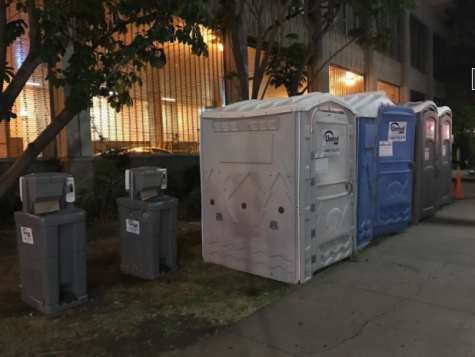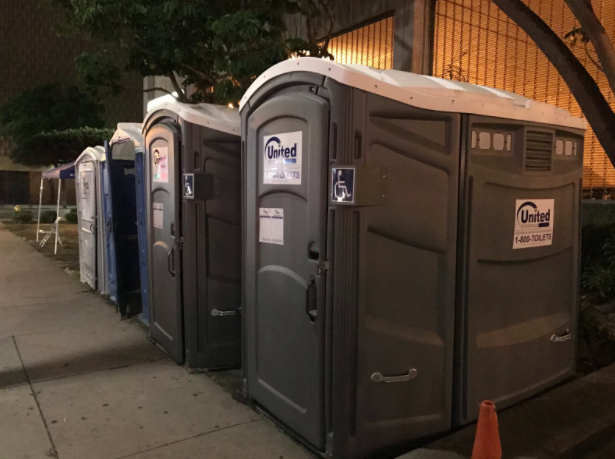San Diego County combats hepatitis A outbreak
Nerine Uyanik
The first set of portable public toilets installed, located in the San Diego downtown region near City Hall at the intersection of First Avenue and C Street, is cleaned twice a day and has 24-hour security. The last time San Diego experienced a hepatitis A outbreak of this scale was in 1996, where the number of cases in the region rose to 645.
October 2, 2017
An outbreak of hepatitis A has infected at least 461 people and killed 17 in San Diego County since last November, largely affecting the homeless and illicit drug-using population. The city has been making efforts to stop the spread of the disease, which was first detected in the county in early March and later declared a local public health emergency on Sept. 1.
Hepatitis A is a virus that causes inflammation of the liver. Though it is not normally fatal, it can be if the infected have other diseases, including hepatitis B or C. According to the Centers for Disease Control and Prevention (CDC), “Hepatitis A is usually spread when a person ingests fecal matter—even in microscopic amounts—from contact with objects, food or drinks contaminated by feces or stool from an infected person.”
The county health department reported that most of those infected are either homeless or illicit drug users, and a large portion of the sickened population falls into both categories. Homeless people often do not have access to public bathrooms and instead have to defecate outside, thus contributing to the spread of the disease. Recreational drug users, especially those who use intravenous drugs, are at risk of contracting hepatitis A through exposure to drugs contaminated with fecal matter from an infected person.
A city-contracted crew started spraying and pressure-washing downtown sidewalks with a diluted sodium hypochlorite, or bleach, solution on Sept. 11 and have since expanded those efforts to include other regions of San Diego. The procedure, set to be repeated every two weeks, is executed in two phases. Contractors first spray down hazardous substances, such as human waste or needles, with a solution of one part bleach to nine parts water. They remove the contaminated items 10 minutes later and respray the area with another solution made by further diluting the first bleach solution with water in a one-to-nine ratio. The crew then ends the procedure by power washing the area with water.
The city has also been installing portable restrooms and hand-washing stations downtown as well as administering vaccinations. Over 42,000 people have been vaccinated as of Sept. 23.

The city of San Diego has installed multiple portable public toilets and hand-washing stations downtown as part of its efforts to combat hepatitis A in the area. The outbreak has infected at least 461 people and killed 17 in San Diego County since last November.
The county has long been battling homelessness, and the outbreak of hepatitis A has incited a ramp up of efforts. San Diego police have been clearing large homeless encampments that, if exposed, could facilitate the spread of the virus.
City workers have been removing roughly three tons of trash and other debris from sidewalks each week. A court order has mandated a 72-hour notice of the cleanup operation to give the approximately 1,000 homeless downtown residents time to pack up their belongings and make way for the cleanup crews.
Some locals, such as Jesi Quinn, find fault with the city’s approach to the issue.
“They are throwing [people’s tents] into this dump truck, and when people come back to their essential “home” that they have, it’s gone,” Quinn said. “I think that it’s their idea of cleaning up the streets of San Diego, which I think is a lazy way of doing it. A lot of the homeless I have encountered either have mental health issues or substance abuse issues or both. I think that [with] the money they already use to summon out the dump trucks, they should use that money to put [the homeless] into a treatment facility or some place where they can go—a shelter with resources so people have places to go–so that they don’t have to be on the street.”
Some homeless advocates say that the homeless run the risk of losing their belongings during the clean-ups even with a settlement that orders that the city keep possessions of value for them until they can retrieve them.
The last time San Diego experienced an outbreak of this scale was in 1996, where the number of cases in the region rose to 645.


















![“[Building nerf blasters] became this outlet of creativity for me that hasn't been matched by anything else. The process [of] making a build complete to your desire is such a painstakingly difficult process, but I've had to learn from [the skills needed from] soldering to proper painting. There's so many different options for everything, if you think about it, it exists. The best part is [that] if it doesn't exist, you can build it yourself," Ishaan Parate said.](https://harkeraquila.com/wp-content/uploads/2022/08/DSC_8149-900x604.jpg)




![“When I came into high school, I was ready to be a follower. But DECA was a game changer for me. It helped me overcome my fear of public speaking, and it's played such a major role in who I've become today. To be able to successfully lead a chapter of 150 students, an officer team and be one of the upperclassmen I once really admired is something I'm [really] proud of,” Anvitha Tummala ('21) said.](https://harkeraquila.com/wp-content/uploads/2021/07/Screen-Shot-2021-07-25-at-9.50.05-AM-900x594.png)







![“I think getting up in the morning and having a sense of purpose [is exciting]. I think without a certain amount of drive, life is kind of obsolete and mundane, and I think having that every single day is what makes each day unique and kind of makes life exciting,” Neymika Jain (12) said.](https://harkeraquila.com/wp-content/uploads/2017/06/Screen-Shot-2017-06-03-at-4.54.16-PM.png)








![“My slogan is ‘slow feet, don’t eat, and I’m hungry.’ You need to run fast to get where you are–you aren't going to get those championships if you aren't fast,” Angel Cervantes (12) said. “I want to do well in school on my tests and in track and win championships for my team. I live by that, [and] I can do that anywhere: in the classroom or on the field.”](https://harkeraquila.com/wp-content/uploads/2018/06/DSC5146-900x601.jpg)
![“[Volleyball has] taught me how to fall correctly, and another thing it taught is that you don’t have to be the best at something to be good at it. If you just hit the ball in a smart way, then it still scores points and you’re good at it. You could be a background player and still make a much bigger impact on the team than you would think,” Anya Gert (’20) said.](https://harkeraquila.com/wp-content/uploads/2020/06/AnnaGert_JinTuan_HoHPhotoEdited-600x900.jpeg)

![“I'm not nearly there yet, but [my confidence has] definitely been getting better since I was pretty shy and timid coming into Harker my freshman year. I know that there's a lot of people that are really confident in what they do, and I really admire them. Everyone's so driven and that has really pushed me to kind of try to find my own place in high school and be more confident,” Alyssa Huang (’20) said.](https://harkeraquila.com/wp-content/uploads/2020/06/AlyssaHuang_EmilyChen_HoHPhoto-900x749.jpeg)






